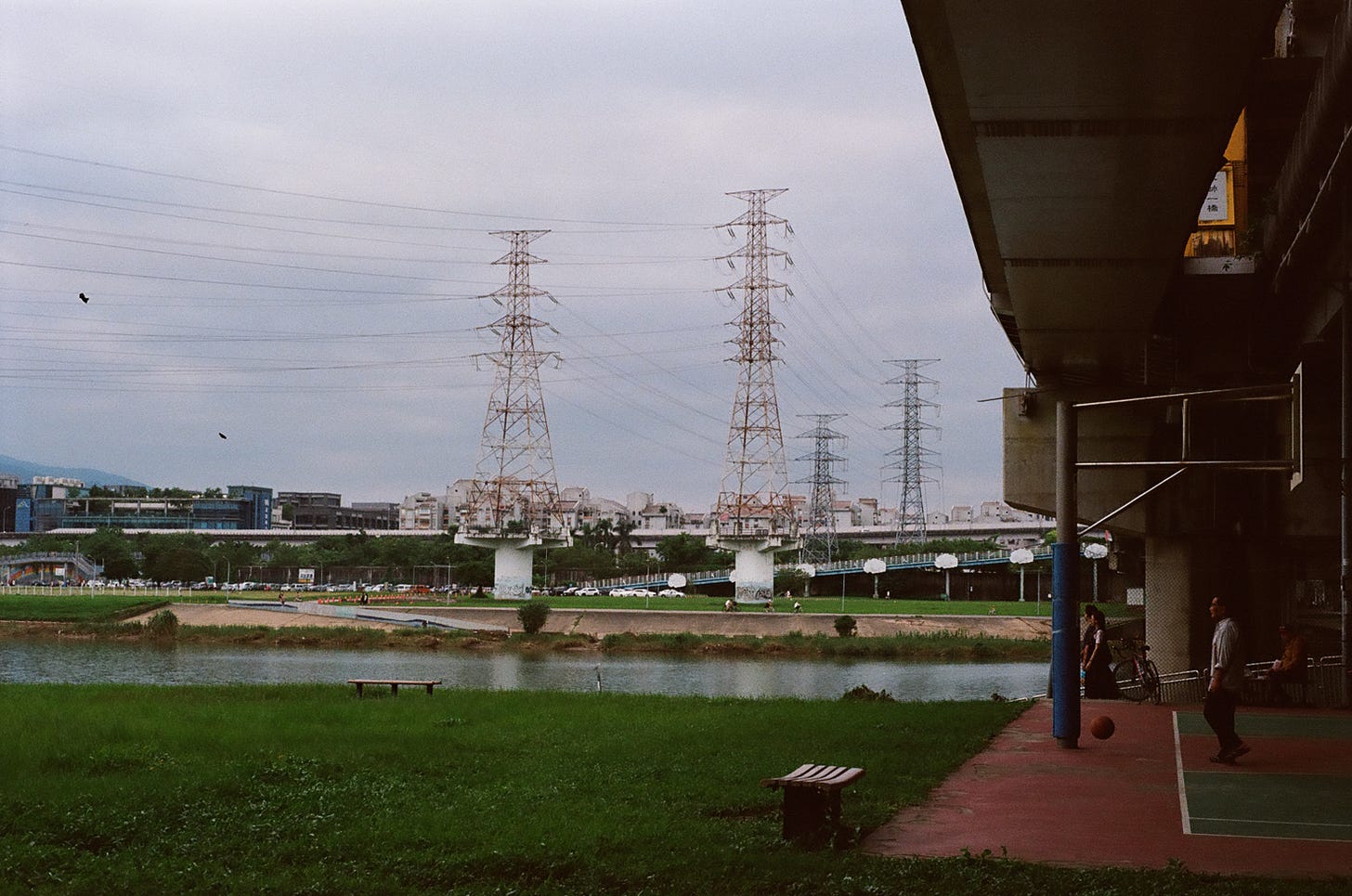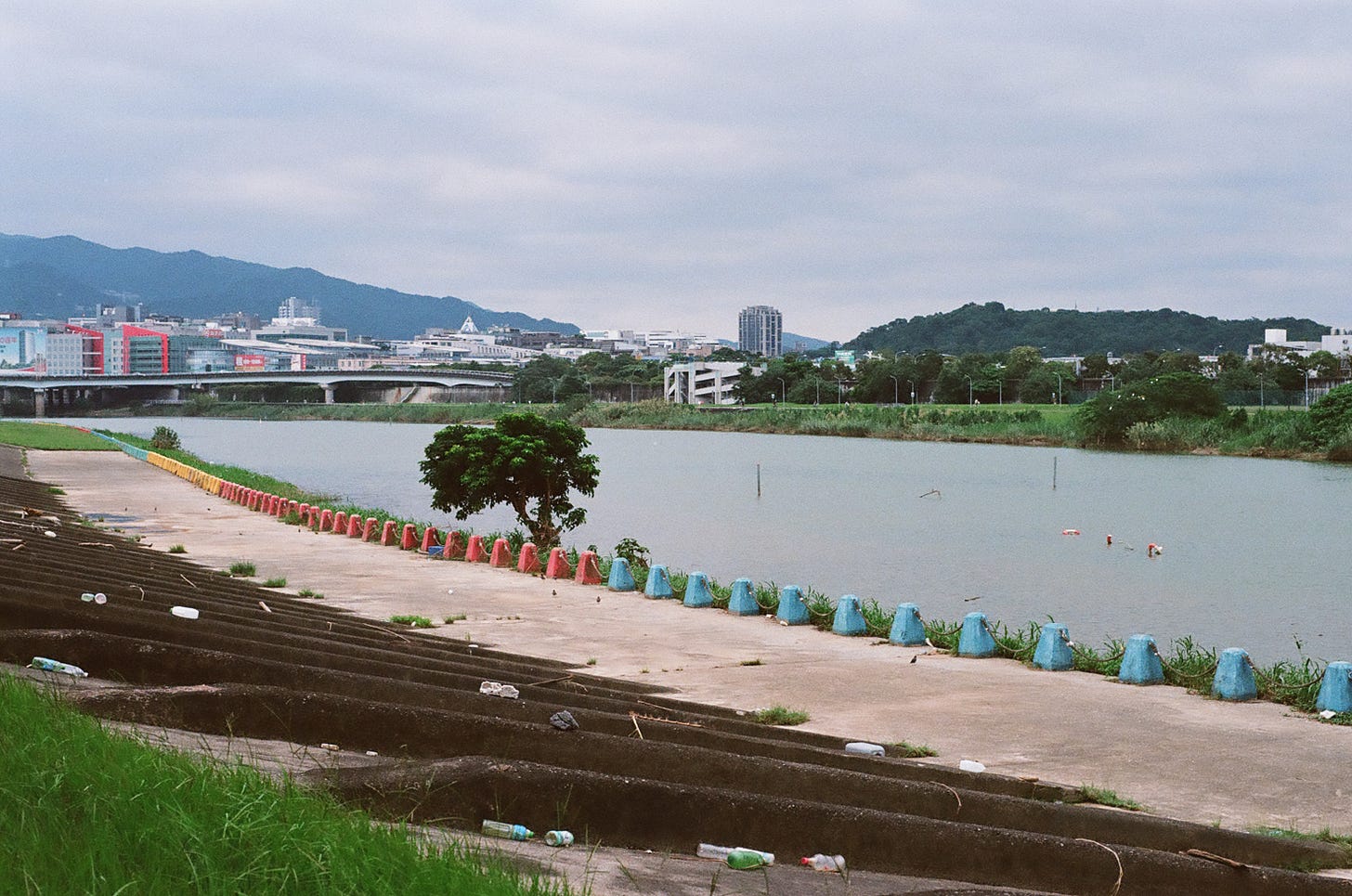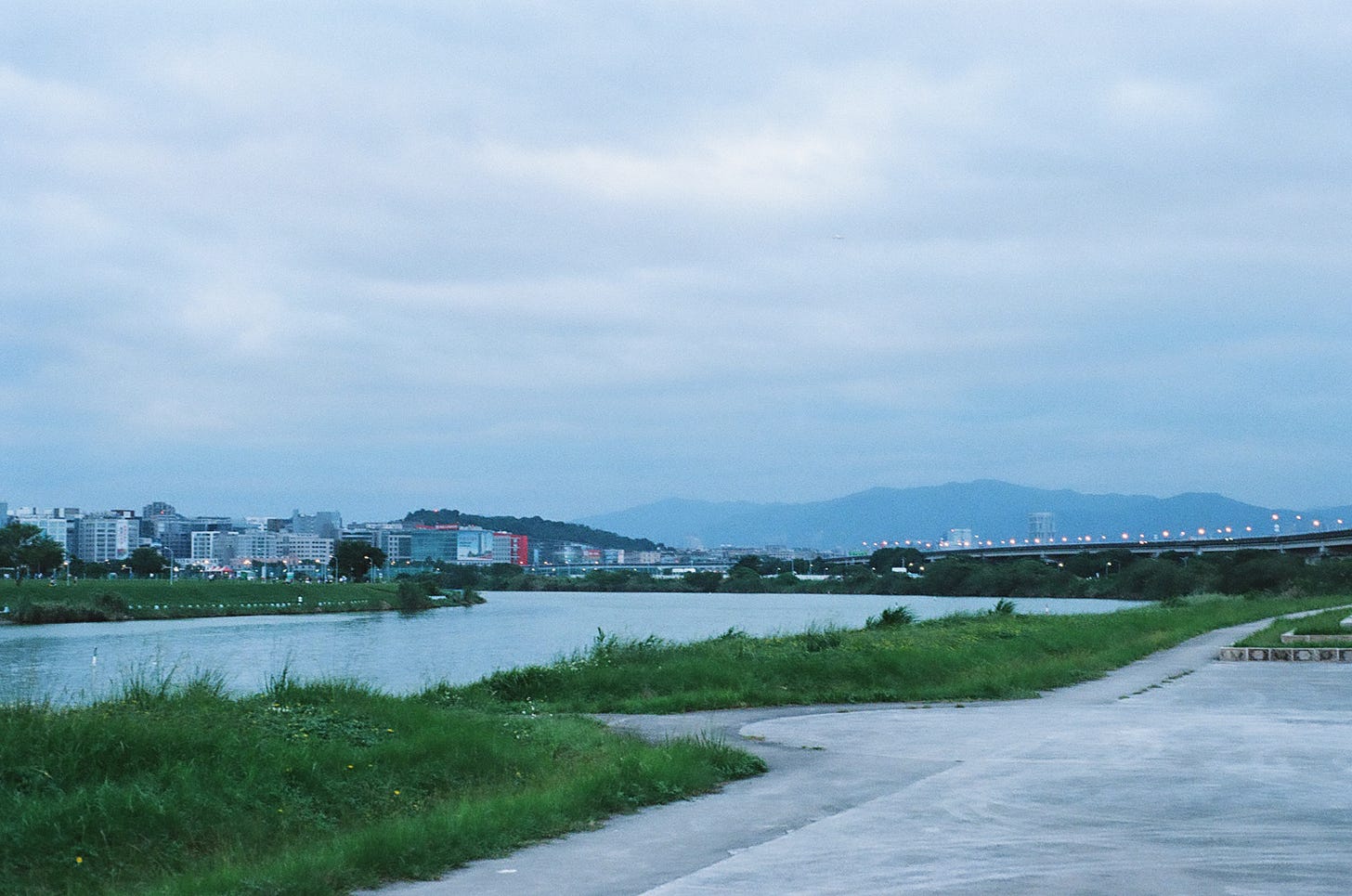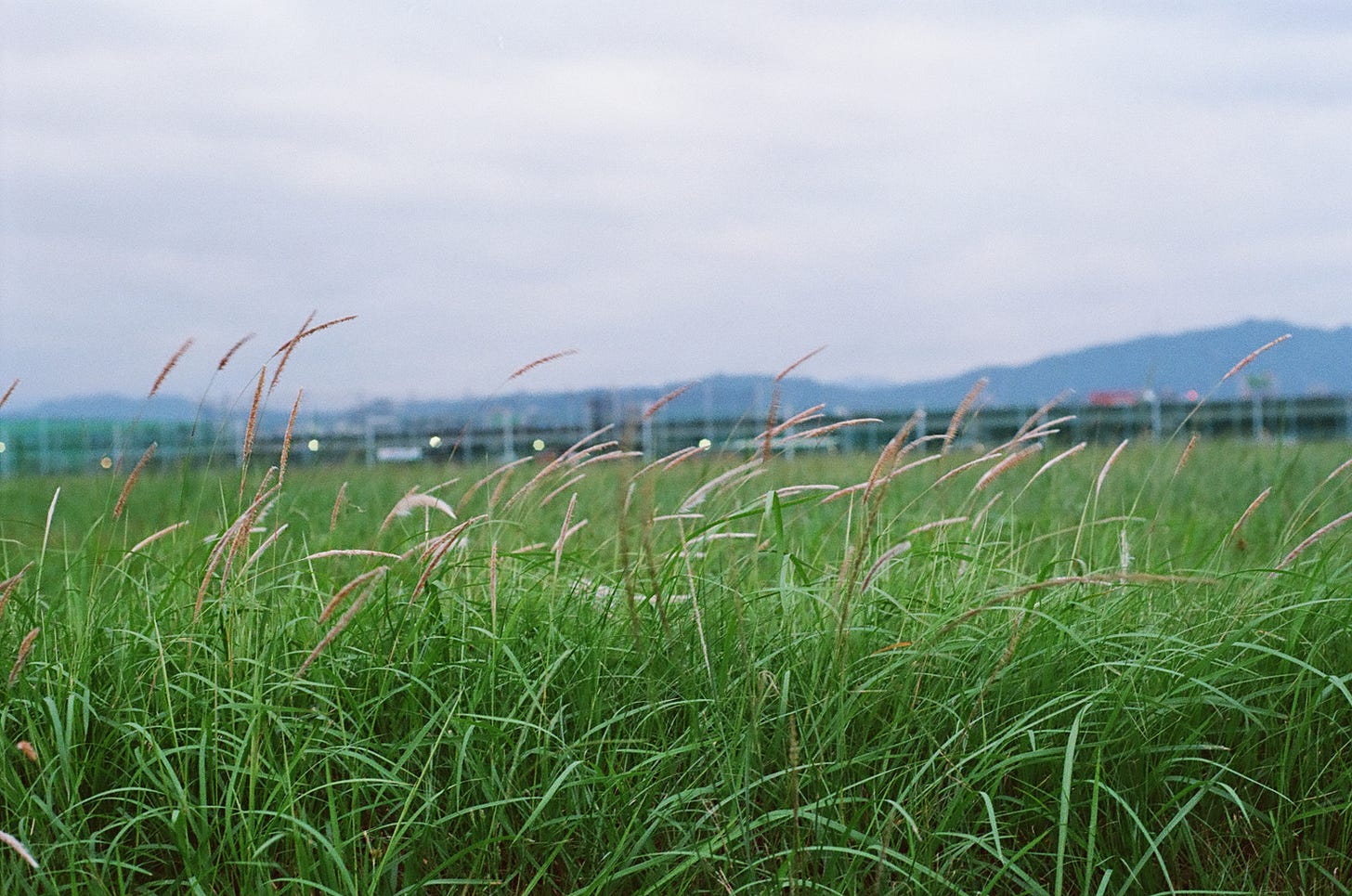The Green Line
Taipei is stitched together by the Mass Rapid Transit (MRT) system. Much like in New York, riding the train is a part of daily life, familiar routes executed on autopilot. I perform my commute to National Tapei University in Sanxia twice a week as if in a dream: Walk to the station. Tap in, board the brown line to Zhongxiao Fuxing, transfer to the Blue Line to Dingpu. Off at Yongning. 916 bus to Sanxia. Off at the University gates. Do the whole thing in reverse in the evening. Days I’m not on campus, my train routine is more variable. The city unrolls logically, stops, transfers, zig-zagging around the city like a chess board, two stops to the west, one stop north...
Each train line is associated with a color and also a tone that plays when the train arrives to the station. Much like the trash trucks which play Beethoven’s Für Elise as they roam the streets, the MRT music sets a mood while serving its primary function of announcement. The Orange line has a bubbling futuristic tone that flavors a commute with the sonic texture of an alien abduction. The Taipower station recently adopted a Hakka-style jazz selection as a nod to its proximity to the Taipei City Hakka Cultural Park.
But my favorite is the Green line which plays Chopin’s Nocturne in E-flat major, Op. 9, No. 2. I stand on the concrete platform and am swept with wistful nostalgia. Sometimes I’ll preemptively play the same nocturne in my headphones so the notes clash and harmonize in the background. The Green line goes from Songshan to Xindian, two places that feel appropriately soft and hazy; tying together two tributaries, the Xindian at its eponymous station and the banks of the Keelung at Songshan.
Sometimes I wonder if I miss New York, and if so, which New York. Taipei is a good place to feel nostalgic, especially with November’s darkness and damp chill (a cold that’s nothing in relation to New York, but the body acclimates). Listening to the music of the Green line echo around the platform, I think about New York in February 2014 when there was thick snow on the ground and I rushed down the street to Storefront for Art and Architecture to work a special Valentine’s themed gallery opening. I was wearing a huge white fluffy coat and black skinny jeans and inexplicably, open-toe high heel sandals. I have an image of looking down at my legs moving and wondering about the cold in my toes, seeing the damp concrete flecked with salt and greying snow. I think about the anticipation and the lip gloss I wore, and the smell of the plywood and fresh-dried paint in the gallery. The rush and crush of the opening follows; pouring wine, drinking wine, the camaraderie of working alongside my friend Ash whom I met at Storefront that spring and years later visited in Taipei when I arrived here for the first time.
It hasn’t snowed like that in New York in a while. The city has changed in the past ten years and so this memory is tinged with the artificiality of a snow globe: how much is invented? Is the snow just shredded foam suspended in the syrupy preservative of nostalgia? The train arrives in Beimen and I climb the escalator into the flat grey air, thick with rain. In ten years will I look back at this moment too, my memory sharpened by the smell of perpetually damp concrete and the sparkling reflections of traffic echoing off the street? In ten years will I close my eyes and listen to Chopin’s nocturne and think of the Green line? What a privilege it is to miss somewhere new.
Notes: Integrating Nature-Based Solutions into Heavily Urbanized River Systems
Nature-Based Solutions (NBS) for flood risk management typically hinges on restoring pre-modified conditions and has been the prevailing approach underpinning the “room for the river” projects that have proliferated across Europe in the past decade or so. The hydrological action is fairly straightforward: a shift from grey infrastructure’s dominant strategy of reducing downstream flooding by increasing river channel flow, to the more green infrastructural approach of increasing upstream holding to disperse peak flow time and decrease overall flow through detention and infiltration. In short: emphasis on flow → emphasis on holding. How is this achieved? Through a catchment approach that centers on the protection, restoration, and enhancement of hydrological and hydromorphological systems. Implementation can be divided into two categories of intervention:
Restoring hydrological processes to reduce stormwater runoff at the source through increasing vegetation cover and making room for floodwater detention. There’s a pluvial focus here that usually involves Sustainable Stormwater Management, Low-Impact Development, Best Management Practices, and similar programs that vary by region.
Restoring the river channel, riparian zone, and floodplain through removing or setting back existing embankments and restoring pre-development fluvial ecosystems. Design practices range from revegetation, changes in management, soil bioengineering, the placement or allowance of large woody debris and log jams, and large-scale river re-meandering.
The implementation of these NBS have proven to be effective in reducing flood risk while also being lower-cost than grey infrastructural implementation.1 However, many case studies are located in rural or semi-rural conditions. The Keelung river represents a common but underexamined case: extensive flood control infrastructure was constructed as a means to allow urban development in the floodplain. Removing or setting back existing embankments in the midstream section of the river (in this case, the area downstream of the Yuanshanzi flood diversion) would lead to significant displacement and is not feasible in the near term. Once the first flood wall goes up it never comes down. The river forms the city, the city forms the river.
Though most of the downstream and midstream of the Keelung is encased in embankments and walls, the basic anatomy of the river still exists. There are a few adjacent discourses that I believe are worthwhile bridges between NBS theory and its application in highly-urbanized contexts:
Rewilding: At its best, it argues for an increase in wildness, rather than an aspirational return to the wild2. What is possible inside a gradient of wildness?
Landscape Suitability Analysis: Richard Foreman and Ian McHarg are still at the heart of all this but a lot has progressed since desakota theories gained traction.3
Ecosystem-Level Biomimicry: I recently stumbled upon this with a healthy level of skepticism but am increasingly convinced that the insistence on regeneration (a focus on rebuilding function) versus restoration (too often, a focus on rebuilding form) could be very useful here.4 Instead of restoring a river, what would it mean to regenerate a river?
Ultimately, it’s increasingly dawning on me that it is not the map but the section that has the potential to be the contribution of the landscape profession to this conversation… Through section, it’s possible to excavate the river beneath and study in detail and generality the relationship between city and river. Back to the drawing board.
Spray, C.; Black, A.; Bradley, D.; Bromley, C.; Caithness, F.; Dodd, J.; Hunt, J.; MacDonald, A.; Martinez Romero, R.; McDermott, T.; et al. Strategic Design and Delivery of Integrated Catchment Restoration Monitoring: Emerging Lessons from a 12-Year Study in the UK. Water 2022, 14, 2305. https://doi.org/10.3390/w14152305
Massenberg, J. R., Schiller, J., & Schröter-Schlaack, C. (2023). Towards a holistic approach to rewilding in cultural landscapes. People and Nature, 5, 45–56. https://doi.org/10.1002/pan3.10426
Lee, Ying-Chieh, Jack Ahern, and Chia-Tsung Yeh. “Ecosystem Services in Peri-Urban Landscapes: The Effects of Agricultural Landscape Change on Ecosystem Services in Taiwan’s Western Coastal Plain.” Landscape and Urban Planning 139 (July 2015): 137–48. https://doi.org/10.1016/j.landurbplan.2015.02.023.
Blanco, E.; Pedersen Zari, M.; Raskin, K.; Clergeau, P. Urban Ecosystem-Level Biomimicry and Regenerative Design: Linking Ecosystem Functioning and Urban Built Environments. Sustainability 2021, 13, 404. https://doi.org/10.3390/su13010404





